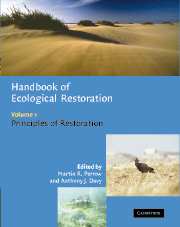Book contents
- Frontmatter
- Contents
- List of contributors
- Foreword
- Preface
- Part 1 The background
- 1 Introduction and philosophy
- 2 Rationale for restoration
- 3 The ecological context: a landscape perspective
- 4 The ecological context: a species population perspective
- 5 The evolutionary context: a species perspective
- Part 2 Manipulation of the physical environment
- Part 3 Manipulation of the chemical environment
- Part 4 Manipulation of the biota
- Part 5 Monitoring and appraisal
- Index
- References
3 - The ecological context: a landscape perspective
Published online by Cambridge University Press: 29 December 2009
- Frontmatter
- Contents
- List of contributors
- Foreword
- Preface
- Part 1 The background
- 1 Introduction and philosophy
- 2 Rationale for restoration
- 3 The ecological context: a landscape perspective
- 4 The ecological context: a species population perspective
- 5 The evolutionary context: a species perspective
- Part 2 Manipulation of the physical environment
- Part 3 Manipulation of the chemical environment
- Part 4 Manipulation of the biota
- Part 5 Monitoring and appraisal
- Index
- References
Summary
INTRODUCTION
Restoration ecology has developed from, and has been practised primarily on, a site-based approach. The restoration of a well-defined area such as a minesite, wetland or a degraded ecosystem of some description is generally attempted. However, it is clear that relatively large areas of the earth are in need of some form of restoration, following degradation through overuse or inappropriate management, which has impaired the functioning or altered the structure of the landscape as a whole (MacMahon, 1998). Thus, there is a need to expand the scope of restoration ecology to embrace broader scales and tackle landscape-scale problems. While this is increasingly recognised, the science of landscape-scale restoration is still in a formative phase (Bell et al., 1997). In this chapter I present a summary of landscape structure and function, discuss the impacts of human modification of landscapes, and present a series of options for developing guidelines for landscape restoration. Some of the material in this chapter is modified from work presented elsewhere (Hobbs, 1995, 1999; Hobbs & Harris, 2001; Hobbs & Lambeck, in press).
LANDSCAPES: STRUCTURE AND FUNCTION
A landscape is defined as an area of land, at the scale of hectares to square kilometres, which consists of a collection of different, but interacting patches (also called landscape elements). Patchiness focuses on the spatial matrix of ecological processes, and emphasises the fluxes of materials and organisms within and between parts of the landscape.
- Type
- Chapter
- Information
- Handbook of Ecological Restoration , pp. 24 - 46Publisher: Cambridge University PressPrint publication year: 2002
References
- 14
- Cited by



